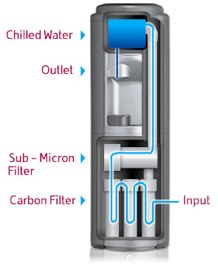These are some of the questions we often hear when people are interested in having a Water Dispenser supplied by our company. I thought I'd share these because they are the questions you should be asking of a supplier if you are looking to purchase a cooler for the office.
FAQ1. I’m confused about the financial benefits. Is it better to buy or rent a Dispenser for my business?
A. Renting is the best option as there’s no advantage to owning the equipment. Usually this includes the installation cost, sanitisation service and repairs due to breakdown of component parts. This means costs are very predictable and there’s no need to budget for any supplies (with the exception of plastic cups or paper cones, if you need them.) There are some other benefits including cashflow (no cash tied up in equipment), upgrades to new equipment (by simply swapping out as you renew or extend your agreement), and replacement of the equipment during the life of the agreement if it breaks down. However, if you still want to own it outright we’d be happy to propose some costs.
FAQ2. I’m not sure if our water supply will reach the place we want a Dispenser. What’s involved in installing a Water Dispenser and will there be any disruption?
A. Normally an installation team will visit the location where you want a Water Dispenser installing. They’ll look for ease of access to water and power and make some recommendations about siting the Dispenser for convenience and for aesthetic appeal. Once the installation team have this information they can carry out the installation and testing process, usually in about 30 minutes, keeping any disruption to an absolute minimum.
FAQ3. I don’t like the taste of tap water. What does the water from one of your Dispensers taste like?
A. The water in a Mains-Fed Dispenser passes through a filtration system. This is designed to remove the unpleasant tastes of heavily chlorinated water from some water utility companies. In blind taste tests most people find it impossible to tell the difference between mineral water and that from a tap that has passed through a dispenser.
FAQ4. We have employees who like a cup of tea or instant coffee during a break. Can a Water Dispenser provide hot water?
A. You can get Dispensers that can deliver chilled, room temperature and water hot enough for a brew up. However, the amount of hot water that can be delivered is only enough for one cup at a time. If you have a number of people all needing hot drinks at the same time we would recommend a dedicated Hot Water Dispenser. These are capable of holding a larger reservoir of hot water for larger groups of people taking the same rest break.
FAQ5. I’m worried about Health and Safety. What are the risks with Water Dispensers?
A. This depends mainly on the type of Dispenser. Bottled fed systems are still quite common. The risks they carry are:
● The bottles are heavy (20Kg or more) and can cause injury to anyone lifting and carrying them in the workplace.
● If water is stored in bottles for a long time (and few carry a “Born on” date) it can experience algae growth, so there is a potential health risk.
● Bottles are recycled and there is no way of knowing where the water came from in the bottle your supplier delivers. Unscrupulous suppliers will often refill from a tap and can be careless with hygiene procedures.
● Spring water elements need not be certified on a frequent basis and do not undergo the same stringent tests as tap water.
Mains-Fed dispensers avoid these problems. All you really need to do is keep the area around the tap clean. The inside of the machine is protected and a sanitisation process that takes care of this as part of a scheduled maintenance visit. In my view, if you are currently using a Bottled Water Dispenser you need to be moving to a mains-fed one. They avoid Health and Safety risks, are cheaper to run and have massive positive impact on the environment.


